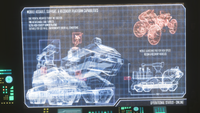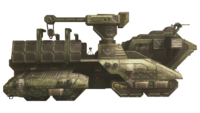M313 Elephant
From Halopedia, the Halo wiki
| M313 Elephant | |
|---|---|

| |
| Production information | |
|
Manufacturer: |
|
|
Product line: |
|
| Technical specifications | |
|
Length: |
|
|
Width: |
|
|
Height: |
11.6 meters (37.9 ft)[2] |
|
Mass: |
|
|
Range: |
|
|
Other system(s): |
|
|
Hull: |
Ultra high density armor plating[5] |
|
Armament: |
|
|
Crew: |
|
|
Complement: |
|
| Usage | |
|
In service: |
|
|
Role(s): |
|
|
Affiliation: |
|
The M313 Heavy Recovery Vehicle[7][3][4][1] is a vehicle in the Elephant line of heavy Mobile Assault, Support, and Recovery (MASR) platforms built by JOTUN Heavy Industries and employed by the United Nations Space Command.[8] Sometimes referred to as the Behemoth-class Troop Transport,[3][4] the vehicle is one of the largest ground vehicles employed by the UNSC for ground-based operations, though since the end of the Human-Covenant War in 2552 it has been surpassed in size by the M510 Mammoth.
Overview[edit]
Design details[edit]
The Elephant is a large, multi-level vehicle driven by eight sets of treads - used to move the vehicle's massive bulk across terrain. The aft of the vehicle is an open-bed cargo bay, featuring a ramp to allow access for personnel and small reconnaissance vehicles (such as Mongooses). The cargo bed contains a readout screen that displays status information on the vehicle and surrounding environment, alongside several equipment crates built into the external walls, including M52B body armor, CH252 helmets, an AIE-486H chaingun and several crates marked NT/B with a biohazard symbol.[8] Another ramp leads from the cargo bed up to a small gantry with access to the fore-mounted cockpit and operator's stations, and a number of mounting points for the vehicle's defensive armaments. A Vulcan LAAG turret overwatch station at the top of the vehicle provides a surrounding view of the area, allowing the Elephant to perform its MASR functions with some defensive options available.[2]
The chassis of the vehicle is heavily-armoured, allowing it to traverse the front lines to transport troops, light vehicles, and cargo to and from the battlefield. The cargo bed is capable of housing up to 16 infantry personnel, and up to six Mongoose recon ATVs or two Warthog FAVs. The vehicle's heavy armour and advanced electronic communications systems (capable of operating in conditions that would hinder most other network systems) also allows it to be deployed into the front lines as a mobile command post for front-line officers.[3][4] Like its M312 cousin, the M313 Elephant is designed to safely transport troops, equipment and light vehicles to and from the frontlines. However unlike its previous model, the M313 Elephant features only one M41 Light Anti-Aircraft Gun with 260 degrees rotation[5] as its armament, though this can be improved with two additional AIE-486H Heavy Machine Guns. It also features numerous firing ports and elevated positions for defending it. Its chassis is also as wide as it is high, providing stability. The vehicle's rear bay lacks the protective armour that is available on the M312 Elephant, thus increasing the vulnerability of its carriage.
The Elephant features a large crane mounted to the starboard side of the vehicle, which is capable of lifting, refuelling, and recover any standard ground vehicle in the UNSC fleet.[3][4]
Background[edit]
Designed and manufactured by JOTUN Heavy Industries, the Elephants were initially used in the utility and farming industries during the early colonial expansion periods.[1] After several decades serving in the civilian market, JOTUN was contracted by the UNSC to develop the Elephants and build them as armored repair and recovery vehicles.[1] As time has progressed, the Elephant has been modified into several variants and upgrades, though the Elephant's versatility remains unchanged.
The Elephant's versatility and commonality means that its basic design template is shared across many other vehicles including the aforementioned colonial vehicles, and even relatively mundane functions such as the Oliphant refuse collection vehicle used in the urban metroplex of New Mombasa.[2]
Known Elephants[edit]
- E-2073 46833-S - UNSC Elephant stationed on Sandtrap (it is interesting to note that both Elephants on the level Sandtrap are almost completely identical, including having the same identification numbers). They both have nicknames: one is called the "Behemoth", while the other is called the "Leviathan", and they both have different insignias painted on their sides. Another means of identification is that below the M41 turret at the front is the number 3 for the Behemoth and a number 5 for the Leviathan, also on the Leviathan is another number 5 on one of the panels at the top of the outer left hand side of the cargo tray.[8]
Gameplay[edit]
At the launch of Halo 3 and Halo: The Master Chief Collection, the Elephant was exclusively available for play on the multiplayer map Sandtrap, located at each end of the map. With the updates given to the Forge mode of Halo 3 for its launch on PC, the Elephant has been made available for placement on other maps including Avalanche.[9] It is completely invincible, and open-topped, unlike its counterpart in Halo Wars. The open roof is probably due to the fact that it is a service and repair station, not a troop carrier.
Inside the Elephant is a large screen which contains information on a Mongoose and the Sandtrap's atmosphere, although it is incredibly hard to read. While the vehicle itself cannot be destroyed, its slow speed and lack of armor for gunners render them quite vulnerable. Killing the driver must be attempted from behind, ideally in a vehicle like a Banshee. In objective-based games, the elephant also serves as a mobile bomb plant/spawn site and flag stand.
In Halo: Spartan Strike, the Elephant is armed with twin cannon and twin missile pods. In Mission A-4, a Zealot Elite hijacks an Elephant, destroying the vehicle from inside out to retrieve the Conduit.
Trivia[edit]
General[edit]
- An elephant is a large, grey mammal native to Africa and southern Asia, in keeping with the UNSC's tradition of naming ground-based vehicles after real animals.
- If the player goes to the bottom level of the Elephant, there is a screen which gives details about the vehicle's specifications, as well as information on a Mongoose and the Sandtrap's atmosphere, although it is incredibly hard to read. There are phrases visible such as Mobile Assault Support and Recovery Platform Statistics and Environmental Analysts. It is interesting to note that it says there are two mobile turrets (that can be ripped off) while there is actually only one. Perhaps one was removed for balance issues as there is a vacant spot opposite the one that is present.
- The Elephant is the only drivable vehicle that can have turrets placed on it without them moving/falling when the vehicle drives off. If a player (in Forge) places a crate or two in the cargo bay of the Elephant, places a turret on top of them and then deletes the crates, then players can drive the Elephant with the turret keeping place over the Elephant.
- The windshield in front of the driver is capable of protecting him from any kind of attack (except Spartan Lasers) without damage; this is probably a balancing action, because the Elephant is a very slow vehicle. In addition, the driver can only be attacked from the back; all other sides are completely protected.
- The Elephant was removed from Sand Tarp, a variant of "Sandtrap", by Bungie.
- On the left-hand side of the Red Team's Elephant there is spray-painted graffiti with text that reads "BEHEMOTH" and a red cartoon picture of a woolly mammoth. On the Blue Team's Elephant it says "LEVIATHAN" and has a picture of a blue, whale-like sea creature sporting a mean grimace and wearing a comically tiny golden crown. The Behemoth and Leviathan are two scriptural creatures that are enormous in stature and girth.
Easter eggs[edit]
- Main article: Elephant flipping
If by some chance the player does manage to flip over an Elephant, the usual “Hold RB to flip [vehicle name]” string entry is replaced with “Hold RB to flip… wait, what? How did you do that?”, referencing the fact that it is the biggest vehicle in the game and that it is seemingly impossible for it to be flipped.
Glitches[edit]
- There are many methods of achieving the flight of an Elephant on the multiplayer map Sandtrap in Halo 3. The first is the well-known technique of filling the hull with explosives—set to instant respawn—and setting them off. This is a trial and error method, and achieves minimal Elephant flight, in which the player lacks control of the flight and trajectory of the vehicle. For more, see Flying Elephant.
- If you place a Covenant hover vehicle like a Karo'etba-pattern Ghost or Qavardu Workshop Prowler on top of the cockpit, and then drive to the center of the Elephant, the vehicle will stay floating as if there were an invisible floor on top of the Elephant. This same glitch (or a similar one) is present in Halo 2, although with the Scarab instead of the Elephant.[10]
- Lag from standbying can allow a player to directly manipulate an Elephant in Forge. In some cases, lag on map variants with a lot of Elephants can have the same effect.
Gallery[edit]

|
Browse more images in this article's gallery page. |
An Elephant in the briefing for the Halo: Spartan Assault mission Escape from Faraday.
List of appearances[edit]
- Halo 3 (First appearance)
- Halo: Spartan Assault
- Halo: Spartan Strike
- Halo: Envoy
Sources[edit]
- ^ Jump up to: a b c d e f g h i j k Halo: The Essential Visual Guide, page 55
- ^ Jump up to: a b c d e f g h i j k Halo Encyclopedia (2022 edition), page 145
- ^ Jump up to: a b c d e f g h i j k l m Halo Encyclopedia (2009 edition), page 236
- ^ Jump up to: a b c d e f g h i j k l m Halo Encyclopedia (2011 edition), page 246
- ^ Jump up to: a b c d Halo 3, Elephant readout
- ^ Halo 3: The Official Guide, page 192
- ^ The Art of Halo 3, page 41
- ^ Jump up to: a b c Halo 3, Elephant in-game vehicle
- ^ Halo Waypoint, MCC Development Update - May 2020 (Retrieved on Jun 1, 2020) [archive]
- ^ YouTube - Generalkidd, Halo 3 - Invisible Floor On "Sandtrap" Glitch
| ||||||||||||||||||||||||||












